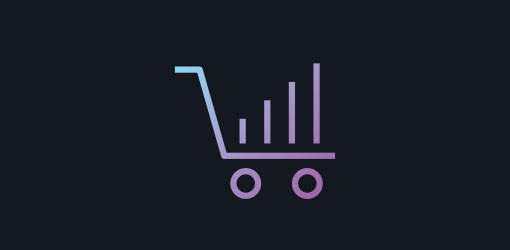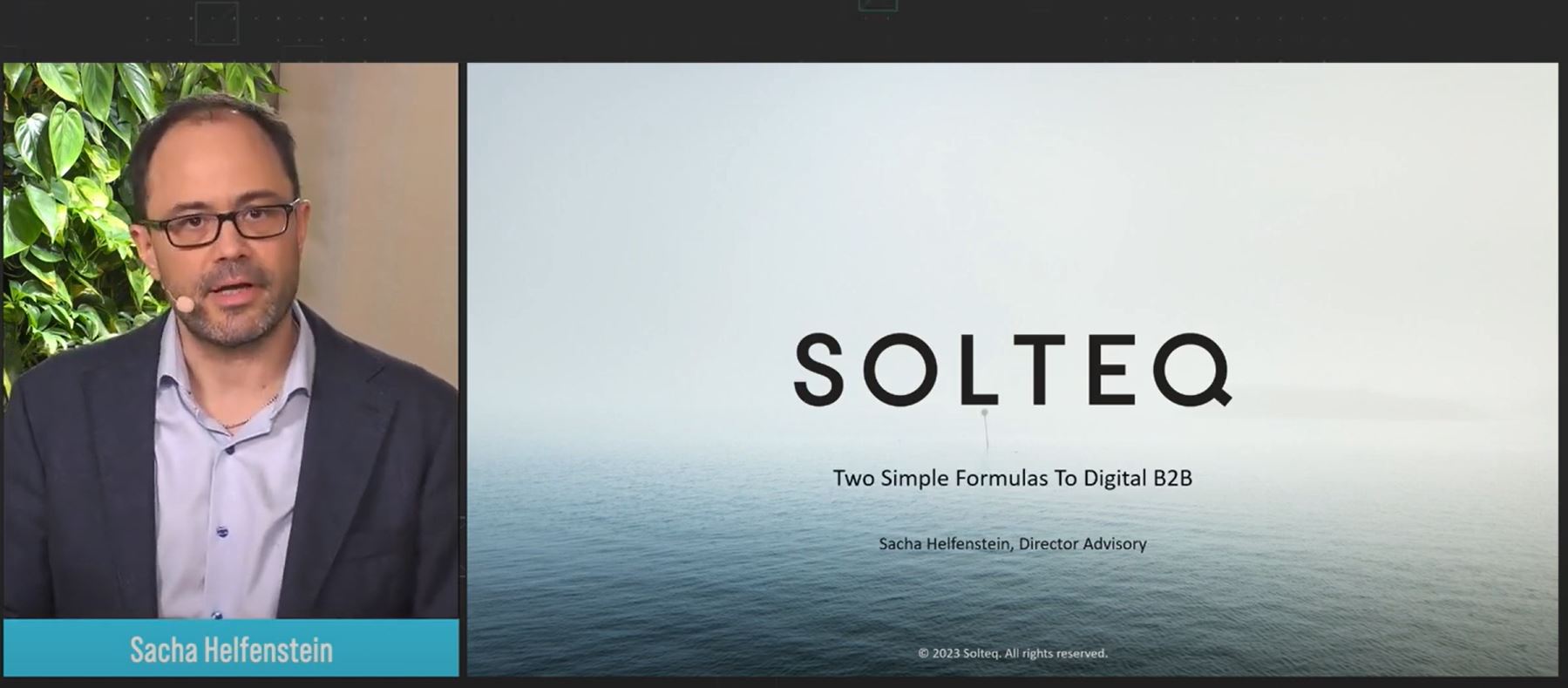Industry insights and more
Webinars, podcasts, eBooks, and other types of insightful contents produced by Solteq or in cooperation with our technology partners. Enjoy!
Browse all or filter for more specific
Language
Content type
Related industry
Technology partner

3+1 päivää verkossa
Vieraana SOK:n kehitysjohtaja Päivi Juntunen. Keskustelussa muistellaan, miten 3+1 päivää -kampanja vietiin verkkoon kolmessa päivässä.
Linkki avautuu YouTubeen.

5 key factors to consider when selecting a POS system for your restaurant
Tips for selecting the right POS system for a restaurant
Learn more >
5 nyckelfaktorer att tänka på när du väljer ett POS system för din restaurang
Tips för att välja rätt kassasystem för restaurangen
Learn more >
5 nøglefaktorer du bør overveje ved valg af et POS-system til din restaurant
Tips til valg af det rette POS-system til restauranten
Learn more >
5 tekijää, jotka kannattaa huomioida ravintolan kassajärjestelmää valittaessa
Vinkkejä ravintolan kassajärjestelmän valintaan
Learn more >
Accelerate Digital Transformation with Faster Master Data Management
Learn how to multiply the impact of trusted, accessible, and timely data on the business and build your data leverage.
Learn more >
Asiakaskokemus digimarkkinoinnissa
Mitä asiakaskokemus digimarkkinoinnissa tarkoittaa ja millaiset asiat korostuvat useiden kanavien kokonaisuudessa?
Linkki avautuu YouTubeen.

Asiakaskokemus seuraavalle tasolle - ota niskalenkki tilaustenhallinnasta
Miten otetaan niskalenkki tilaustenhallinnasta ja valjastetaan kokonaisuus, joka palvelee niin loppuasiakasta kuin liiketoimintaa.
Linkki avautuu YouTubeen.

B2B: Gearing up for Digital B2B
This eBook helps businesses to gear up for digital B2B. The eBook is designed for business leaders, who want to base their company's business development strategy and digital investments on a solid foundation regarding B2B online presence and digital experience.
Learn more >

Composable Commerce: Revolutionizing the E-commerce Landscape
In today's rapidly evolving digital landscape, businesses are constantly searching for innovative solutions to stay ahead of the competition and meet the ever-changing demands of their customers. Traditional commerce platforms that offer a one-size-fits-all solution from a single vendor are no longer sufficient.
Learn more >
D2C: Opportunities and Challenges
This eBook introduces Solteq's take on D2C, exhibits its main opportunities and challenges and indicates business capabilities needed.
Learn more >
D2C: The Incumbent's Dilemma
This eBook introduces the concept of the "incumbent's D2C dilemma" and how to assess the potential of launching a digital sub-brand
Learn more >
Datan rooli energiayhtiön toiminnan kehittämisessä
Miten data saadaan aidosti mahdollistamaan liiketoiminnan kehittämistä? Minkälaisilla askeleilla kannattaa lähteä liikkeelle ja mitä on realistista tavoitella?
Learn more >
Decoding the Future of E-Commerce: Navigating Composable Commerce, Headless Commerce, and Microservices for Business Success
In the ever-evolving realm of e-commerce, businesses are presented with a multitude of strategies to enhance their online presence and customer experiences.
Learn more >
Deep Vision - Determining reasons why visitors abandon your Marketing Conversion Funnel
Within this webinar we will discuss how Customer Behaviour can determine a much deeper understanding of your customers experience, from campaign to visit and all factors in-between.
Link opens to YouTube.

Deep Vision - The Importance of Ecommerce Search
Discover the Importance of Ecommerce Search and understand why poor search functionality is a conversion killer.
Link opens to YouTube.

Digitaalista läpinäkyvyyttä maailmanlaajuisestiLove My eCom - Redefining eCommerce experience
Vieraana ABB Oy:n Drives-liiketoimintayksikön tietohallintopäällikkö Jukka Itkonen. Kuule Order Tracker -projektista jonka avulla parannettiin tilaus- ja toimitusketjun läpinäkyvyyttä sidosryhmille.
Linkki avautuu YouTubeen.

Feel my Business
Tiedolla johtamisesta on puhuttu toimialasta riippumatta jo vuosikausia, mutta syystä tai toisesta monessa organisaatioissa ollaan edelleen takamatkalla, vaikka työkaluja on saatavilla.
Linkki avautuu YouTubeen.

Fra transaktioner til transformationer: Udnyttelse af POS systemer til øget salg
Point of Sale (POS) systemer er blevet en integreret del af moderne forretningsdrift. Traditionelt blev disse systemer primært brugt til at håndtere transaktioner, men de er udviklet til meget mere end det.
Learn more >
From Transactions to Transformations: Leveraging POS Systems for Enhanced Sales
Point of Sale (POS) systems have become an integral part of modern business operations.
Learn more >
Från transaktioner till transformationer: Utnyttja kassasystem för förbättrad försäljning
Point of Sale (POS) -system har blivit en väsentlig del av modern företagsverksamhet.
Learn more >

Hyvää voi tehdä myös verkossa
Vieraana Suomen Punaisen Ristin ketjuohjauksen päällikkö Tiina Sippula. Millaista roolia digitalisaatio näyttelee Punaisen Ristin Kontin toiminnassa ja miten verkkokaupan avulla parannetaan asiakaskokemusta.
Linkki avautuu YouTubeen.

Itsepalvelukassat vähittäiskaupassa
Itsepalvelun mahdollistaminen lisää asiakastyytyväisyyttä vähittäiskaupassa
Learn more >
Johdatko tiedolla vai mutulla?
Istahda kanssamme selkeää suuntaa ja oikeaa toimintaa tuottavan älykkäämmän datan asialla. Kolme osuvaa puheenvuoroa tarjoavat syväsukelluksen datan hyödyntämisen maailmaan.
Linkki avautuu Vimeoon.

Järjestelmätoimittajasuhteiden hallinta tilaajan näkökulmasta
Miten tilaaja voi omalla toiminnallaan edistää tietojärjestelmäkehitystä ja tavoitteiden saavuttamista? Mitkä ovat toimivan tietojärjestelmätoimittajasuhteen kulmakivet?
Learn more >
Kauneutta verkosta
Vieraana Transmerin Kimmo Koho. Miten digitalisaatio on muuttanut ja helpottanut toimintaa kauneusalan yrityksessä, joka myy useita brändeja ja lukemattomia tuotteita useassa eri verkkokaupassa.
Linkki avautuu YouTubeen.

Kiss my PIM - Mitä ihmettä?
Rakkaudesta digiin -podcastin ensimmäisessä jaksossa keskustellaan tuotetiedonhallinnasta.
Linkki avautuu YouTubeen.

Kulutusjouston merkitys ja mahdollisuudet energiayhtiöille
Pureudumme syihin kulutusjouston kasvavan tarpeen takana, ja sen tarjoamiin hyötyihin osana toimivaa sähköjärjestelmää. Pohdimme myös, mitä yhtiöiden kannattaa tehdä juuri nyt, jotta jouston hyödyt saadaan täysimittaisesti realisoitua.
Learn more >
Kysyntäjouston verkkosääntö: mikä muuttuu?
Käsittelemme verkkosäännön taustaa, aikataulua sekä sen vaikutuksia verkkoyhtiöiden liiketoimintaan. Asiantuntijavieraana webinaarissa on Visa Simola Fingdiristä.
Learn more >
Light My Data - From insights to action
Miten hyödyntää dataa asiakaskokemuksen kehittämisessä, ja kuinka tiedolla johtaminen tuodaan osaksi arkea?
Linkki avautuu Vimeoon.

Light My Data: Datan luotettavuus
Elämme datakeskeisessä aikakaudessa. Tietoa syntyy joka hetki, sitä tallennetaan, muokataan ja pyritään hyödyntämään eri käyttötarkoituksiin. Mutta onko kaikki data hyvää ja hyödynnettävää?
Linkki avautuu Vimeoon.

Love My eCom - Building great professional experience with B2B eCommerce
Livenaarissa paneudumme B2B-verkkokaupan erityispiirteisiin ja trendeihin.
Linkki avautuu Vimeoon.

Love My eCom - Redefining eCommerce experience
Livenaarissa keskustelemme verkkokaupan menestystekijöistä, tuotetiedon tuomista mahdollisuuksista sekä markkinapaikkojen hybridistrategiasta.
Linkki avautuu Vimeoon.

Love My eCom - The future is customer-driven
Livenaarissa saat katsauksen pandemian vauhdittamaan verkkokauppaan ja nouseviin trendeihin.
Linkki avautuu Vimeoon.

Love My eCom: Konversiot kaakkoon
Mikä yhdistää menestyviä verkkokauppoja? No kovat konversiot ja isot keskiostokset tietenkin! Mutta kuinka varmistaa, että niihin päästään?
Linkki avautuu Vimeoon.

Markkinoinnin automaatio opas
Opas johdattelee sinut läpi markkinoinnin automaation keskeisimpien strategioiden ja auttaa projektin käynnistämisessä.
Learn more >
Miksi energiayhtiö tarvitsee toistettavan versiotestaussuunnitelman?
Mikä on tilaajan oman version vastaanottotestauksen rooli versiopäivityksissä? Mitä toimivasta versiotestauksesta ja löytyy ja kuinka toteuttaa testaukset onnistuneesti?
Learn more >
Mistä tietää, mikä on se oikea?
Rakkaudesta digiin -podcastin neljännessä jaksossa käsittelyssä on verkkokauppa-alustan valinnanvaikeus - mistä tietää, mikä on oikea vaihtoehto omalle yritykselle?
Linkki avautuu YouTubeen.

Miten pitää ajantasaiset saldot kassalla ja verkossa
Katso livenaari tallenne ja opi mitä hyötyjä saat irti uudenajan kassoista.Tule kuulemaan mitä hyötyjä saat irti uudenajan kassoista.
Linkki avautuu YouTubeen.

Miten voit vauhdittaa yrityksesi myynnin kasvua modernin kassajärjestelmän avulla?
Kassajärjestelmät (Point of Sale, POS) ovat tulleet olennaiseksi osaksi modernia liiketoimintaa.
Learn more >
Mitä kaikkea B2B-asiointialusta mahdollistaa vuonna 2022
Mistä DXP:ssa on ihan oikeasti kyse? Pitäisikö B2B-toimijoiden heittäytyä suuriin ja työläisiin portaalihankkeisiin?
Linkki avautuu YouTubeen.

Mitä verkkokauppa Puuilossa tarkoittaa, pakko vai mahdollisuus?
Vieraana Puuilon Juha Saarelan. Millainen merkitys verkkokaupalla on Puuilon liiketoiminnassa, onko se pakko vai mahdollisuus?
Linkki avautuu YouTubeen.

Navigointi muutoksessa: prosessityön merkitys energia-alan johtamisessa
Webinaari tarjoaa luotauksen prosessityön rooliin energiayhtiöiden liiketoiminnassa ja muutoksen hallinnassa. Käsittelemme mm. kuinka selkeä prosessikuvaus ja hyvin määritellyt toimintamallit muodostavat perustan onnistuneille muutoshankkeille.
Learn more >
Nordic eCommerce trend report 2025
Are you ready to stay ahead in 2025? Our Nordic eCommerce Trend Report offers an in-depth look at what’s shaping the Nordic digital marketplace.
Learn more >
Nordic eCommerce trend report 2026
As the digital landscape accelerates, Nordic businesses are at a crossroads: evolve or fall behind.
Learn more >
Online-liiketoiminnan kasvun avaintekijät
Menestyminen online-liiketoiminnassa on monen asian summa. Ei riitä, että sinulla on käytössä markkinoiden kuumin verkkopalvelualusta.
Linkki avautuu YouTubeen.

Online-liiketoiminnan käsikirja
Tämä verkkoliiketoiminnan kehittämisen käsikirja avaa online-liiketoiminnan menestystekijöitä. Opas on suunniteltu kaikille online-liiketoiminnan parissa työskenteleville, jotka haluavat kasvattaa bisnestään ja parantaa oman verkkoliiketoimintansa kannattavuutta.
Learn more >
Parempaa bisnestä datalla
Vieraana Saxon digitalisaatiojohtaja Markku Rantala. Digitalisointi siirtyy koko ajan yhä tärkeämpään rooliin yrityksen kehityksessä, eikä sitä kerta kaikkiaan ole varaa jättää tekemättä.
Linkki avautuu YouTubeen.

PIM eBook
This eBook isn’t just about the basics (though we cover those too!). We dive deep into how AI can take your PIM strategy to the next level, how to build the perfect team around your PIM system, and even how to improve your SEO game with better product data.
Learn more >
PIM megatrends
This fifth episode is hosted in English as it features Thor Johnson, CEO of inriver at PIMpoint Americas 2019. What are the most important PIM-related megatrends?
Link opens to YouTube.

PowerPark
PowerParkin haasteena oli myynnin varmistaminen ja huvipuistoelämys ravintolan ruuhka-aikoina. Solteqin itsepalvelukassa mahdollisti lisämyynnin ja hyvän asiakaskokemuksen.
Linkki avautuu Vimeoon.

PowerPark
The challenge facing PowerPark was to ensure sales and a positive customer experience during the restaurant's busiest hours.
Link opens to Vimeo.

PowerPark
Udfordringen for PowerPark var at sikre salg og oplevelser i forlystelsesparken, når der var travlhed i restauranten.
Link åbner til Vimeo.

PowerPark
Utmaningen för PowerPark var att säkerställa försäljning och en positiv kundupplevelse under restaurangens mest trafikerade timmar.
Länken öppnas till Vimeo.

PowerPark
PowerParks utfordring var å forsikre salg og fornøyelsespark opplevelser også under restaurantens rushtider.
Link åpnes til Vimeo.

Rock Your Online Business
Vieraana Tokmannin Markus Sinisalo. Mitä oppeja Tokmannin verkkokauppamatkalla on kertynyt ja mitkä ovat olleet kriittisiä menestystekijöitä?
Linkki avautuu YouTubeen.

Sammenhængende logistik og arbejdsprocesser på lageret sparer tid og penge
På dette webinar giver vi dig indblik i, hvordan en strømlinet og sammenhængende lager- og logistikfunktion ser ud, når de to førende løsninger på markedet, Tasklet Factory WMS og Logtrade, arbejder sammen.
Linket åbner til YouTube.

Self-Service Boom: What It Means for Commerce Beyond the Counter
The retail landscape is transforming significantly with the widespread adoption of self-service checkout systems.
Learn more >
Self-service checkouts in retail
Enabling self-service enhances customer satisfaction in retail
Learn more >
Selvbetjeningskasser i detailhandlen
Forbedret selvbetjening øger kundetilfredsheden i detailhandlen
Learn more >
Självbetjäningkassor i butik
Att möjliggöra självbetjäning förbättrar kundnöjdheten inom detaljhandeln
Learn more >
Solteq Commerce Cloud offers a market-leading solution for HC Porin Ässät
Due to the strong growth of the restaurant and events business, HC Porin Ässät decided to upgrade its old POS system.
English subtitles available.
Link opens to YouTube.

Solteq Commerce Cloud supports the growth
Padel Club Finland uses the cash register system in many ways. Self-service checkouts enable customer service even when staff is not present.
English subtitles available.
Link opens to YouTube.

Solteq Commerce Cloud tukee Padel Club Finlandin laajentumista
Padel Club Finland käyttää kassajärjestelmää monipuolisesti. Itsepalvelukassat mahdollistavat asiakaspalvelun myös silloin, kun henkilökuntaa ei ole paikalla.
Linkki avautuu YouTubeen.

Solteq Commerce Cloud vastasi kaikkiin Porin Ässien kassajärjestelmälle asettamiin vaatimuksiin
Ravintola- ja tapahtumaliiketoiminnan voimakkaan kasvun johdosta HC Porin Ässät päätti päivittää vanhan kassajärjestelmänsä.
Linkki avautuu YouTubeen.

Sähkömarkkinoiden ajankohtaiskatsaus 2024/Q3
Käsittelemme sähkömarkkinoiden tulevien muutosten aikataulua roadmapin muodossa, Fingridin toteuttamaa kuormanohjausrajapinnan selvitystä, kulutusjouston verkkosääntöä sekä sähkön vähittäismarkkinasääntelyä.
Learn more >
Sähkömarkkinoiden ajankohtaiskatsaus 2024/Q4
Käymme läpi sähkömarkkinoiden varttisiirtymää ja sen vaikutuksia yhtiöiden liiketoimintaan, energia-alan kehityksen suuntaa ja tulevaisuuden näkymiä sekä joustopalveluiden hankintaehtoja.
Learn more >
Sähkömarkkinoiden ajankohtaiskatsaus 2025/Q1
Syvennymme toiminnanohjausjärjestelmien trendeihin, varttisiirtymän mahdollisuuksiin ja datan merkitykseen energia-alalla.
Learn more >
Sähkömarkkinoiden ajankohtaiskatsaus 2025/Q2
Agendalla joustopalveluehdot, joustavat liittymissopimukset, asiakkaiden osallistaminen joustoon, regulaatio ja sähkömarkkinatutkimuksen tuloksia.
Learn more >
Sähkömarkkinoiden ajankohtaiskatsaus 2025/Q3
Agendalla Kulutusjouston tarpeiden selvittäminen ja niistä viestiminen markkinoille sekä tekoälyn hyödyntäminen energiayhtiön liiketoiminnassa.
Learn more >
Tehosta toimitusketjua
Vieraana Alkon tietohallintojohtaja Kaapro Kanto. Kuuntele, miten digitalisaatio on muuttanut Alkon toimintaa ja millaisia mahdollisuuksia se on luonut liiketoiminnalle.
Linkki avautuu YouTubeen.

The Cornerstones of Omnichannel Retail 2020
Why is it so challenging to build omnichannel business models? - with a very special guest from the University of Oxford.
Link opens to YouTube.

The Power of Personalization in Digital Commerce
Our experts will guide you through understanding how adopting a personalization mindset is as crucial as the actionable tasks themselves.
Learn more >
The Silent Engine Behind Smarter Commerce: Rethinking the Role of POS
Point of Sale (POS) systems have undergone a significant transformation, evolving from simple cash registers to comprehensive business management tools.
Learn more >
The Value of Composable Commerce
Traditional e-commerce platforms often struggle to keep up with this dynamic environment, leading to limitations in flexibility, scalability, and innovation. However, composable commerce offers a solution to these challenges by providing a highly customizable and flexible e-commerce platform.
Learn more >
Tiedolla johdat paremmin
Vieraana Alva-yhtiöt Oy:n asiakkuusjohtaja Jukka Pennanen. Läpi käydään optimoidun vesihuollon palvelukokonaisuuden, Dashboard-hankeen lähtökohtia, haasteita, oppeja ja onnistumisia.
Linkki avautuu YouTubeen.

Two Simple Formulas To Digital B2B You Should Understand
The presentation by Sacha Helfenstein at Smart Commerce Nordic 2023
Link opens to YouTube.

Unleashing Growth Through Composable Commerce's Strategic Business Benefits
Enter "Composable Commerce," a groundbreaking paradigm revolutionizing how companies approach their online operations. Unlike monolithic e-commerce platforms, Composable Commerce offers a modular and agile approach, allowing businesses to create tailored and seamless digital experiences by integrating best-of-breed solutions.
Learn more >
Vastuullisuusregulaatio - Sääntelyyn vastaamisesta kohti kilpailuetua
Käymme läpi uusia horisontissa näkyviä vastuullisuusvaatimuksia, käsittelemme miten niiden mukaisesti toimiminen edellyttää datan laajamittaista hyödyntämistä ja sivuamme lopuksi sitä, miten vastuullisuusprojektin käynnistämistä kannattaa lähestyä.
Learn more >
Verkkoliiketoiminnan kuumimmat trendit 2019
Rakkaudesta digiin -podcastin kolmannessa jaksossa keskustelu pyörii tällä kertaa verkkobisneksen kuumimpien trendien ympärillä.
Linkki avautuu YouTubeen.

Verkossa asioimisen helppous
Vieraana Bauhausin Suomen ja Viron markkinointijohtaj Viivi Niemi. Miten perinteinen toimiala istuu verkkoon.
Linkki avautuu YouTubeen.

What You Really Need to Know Before Choosing a POS System
For many business owners, the world of point-of-sale technology still feels like unfamiliar territory.
Learn more >
Why should I kiss PIM? Sammakosta prinssiksi tuotetiedon avulla
Rakkaudesta digiin -podcastin toisessa jaksossa jatketaan keskustelua PIMin, eli tuotetiedon tuomasta lisäarvosta yrityksille.
Linkki avautuu YouTubeen.

🎙️ How to simplify personalization - without losing the human touch
Is your personalization strategy helping customers or creeping them out?
Learn more >
🎙️ Simplifying Accessibility: Turning compliance into competitive advantage
The true motivation for improving digital accessibility isn’t about avoiding fines, it’s about prioritizing your users.
Learn more >
🎙️ This is not a test: AI is already changing everything
Artificial intelligence is everywhere; in our tools, our headlines, and our boardroom strategies. But while the hype grows, so does the confusion.
Learn more >Subscribe to our Blog
You will get valuable insights and inspiration to develop your digital business solutions.









